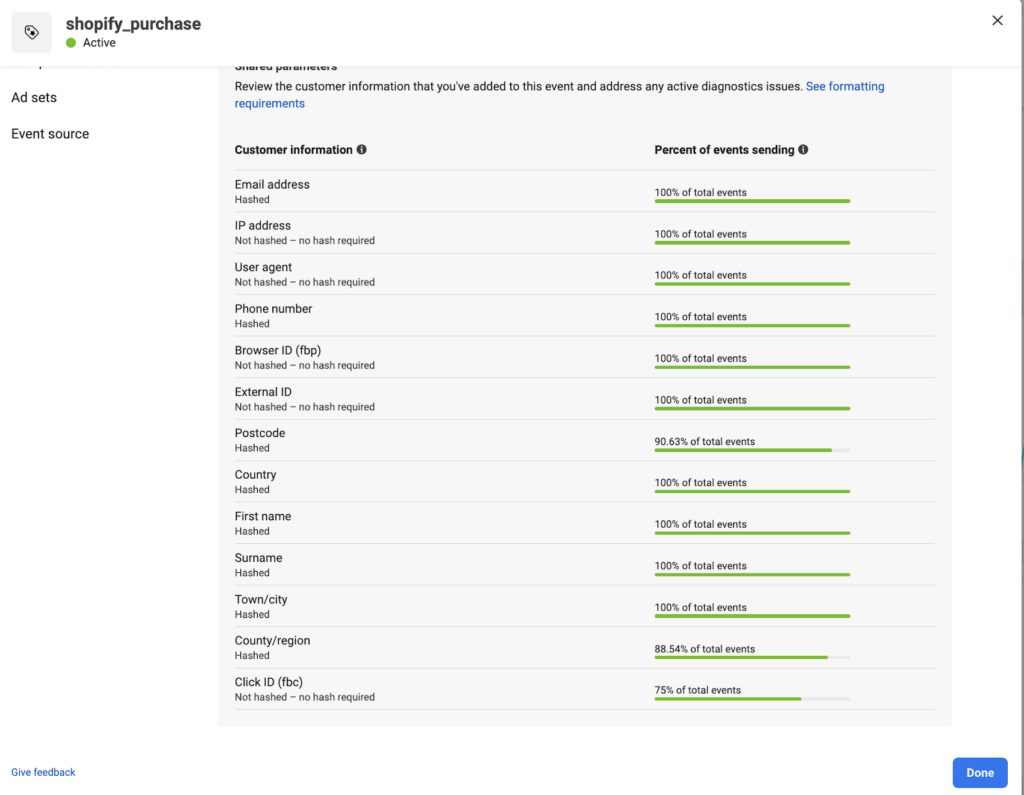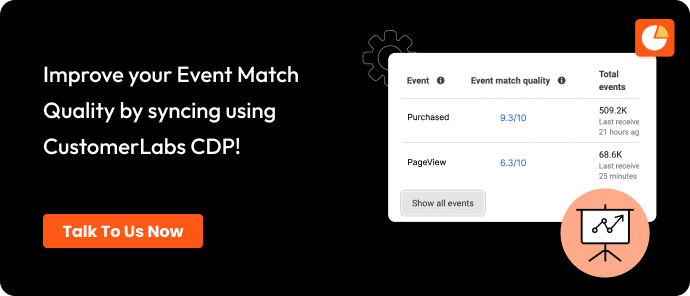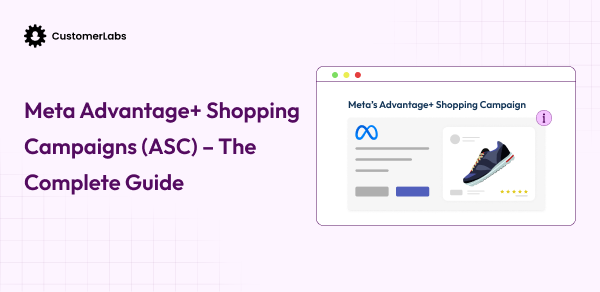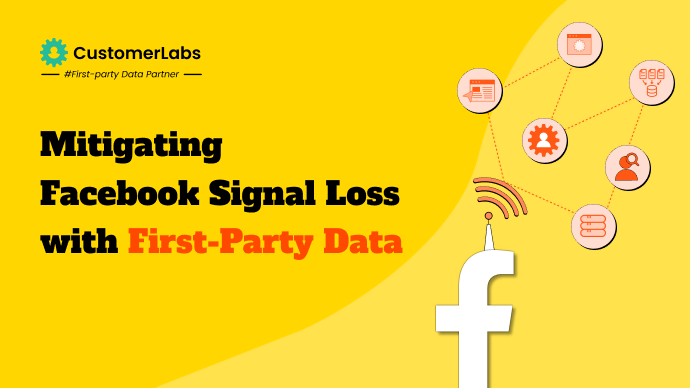Marketers are now going through a rough patch as the privacy rules are closing in and consequently facing a major drop in ad campaign performance. Meta recommends improving the Event Match Quality (EMQ) to see better ad campaign performance. To increase the EMQ score all you need to do is send specific parameters to Meta.
Meta has recently changed the priorities of the parameters that have to be synced with it to improve the EMQ score. Facebook Click ID (FB Click ID/fbclid) and Email ID top the list based on priority. Let’s dive in and debunk what FB click ID is, how it works, and ways it can help enhance ad campaign performance.
What is FB Click ID/FBC?
FB click ID, represented as fbc or fbclid, is a unique ID, that is, automatically created when a user clicks on a Facebook ad and lands on the website. The purpose of this ID is to pinpoint and track users who clicked on the Meta ad. It is a key parameter that helps to better measure ad campaign conversions.
For instance, when a user clicks on a Facebook ad and ends up on a website with Meta Pixel, there are special cookies called fbp and fbc that assign fbclid to the user and start tracking their behavior. Meaning, the Meta pixel tells the website, “Hey, this person came from a Facebook ad!” and starts tracking the user.
If your browser doesn’t accept cookies or if the website doesn’t have the Meta Pixel with first-party cookies set up, the fbclid is generated as a query parameter at the end of the URL anyway, catching the user in the act.

The fbclid is nothing but a bunch of characters added at the end of the URL used to identify the user and attribute the user to the ad campaign. Ergo, be it a known user or an anonymous user, you can identify and track the events of a user seamlessly using fbc.
Why is Facebook Click ID important?
Below are the three reasons why FB click ID is inevitable for enhancing campaign performance
- The first and biggest reason that made FB click ID famous overnight is that Meta changed the priorities of parameters needed for improving the EMQ score. It brought FB Click ID which was of low priority to high priority in the list of parameters that help improve the EMQ score. If Meta considers fbclid as a high priority then so must we. Leveraging the fbc parameter for event matching is key for campaign performance.
- The fbc helps identify and track the journey of even anonymous users who could be potential customers. It also improves conversion attribution where Meta can find the ad that resulted in conversion. Simply put, a user clicks on a product’s Facebook ad and buys it. If we track the user journey using fbclid then we can know which ad led them to buy the product.
- Offline conversion tracking too can be easily done using fbclid. Let’s say your client owns a local coffee shop and you want to track how many customers visit the cafe after clicking on a Facebook ad. Through fbc and offline data, you can gain insights into which ads are driving offline conversions and optimize your marketing strategy accordingly.
How does FBCLID operate?
So, it all starts when a user clicks on a Facebook ad and ends up on a website. Facebook does some behind-the-scenes play and creates fbclid recognizing the event. Now, Facebook’s little helper, the Meta pixel, steps in and saves the fbclid in a cookie called fbc. It’s like a little note tucked away in your browser that says, “This person clicked on this Facebook ad.”
Now, two things can happen
One, the fbc generated is captured and is tracked along with the user journey on the website. Let’s say the user clicked on ‘buy now’, and purchased a red shirt. The user’s details including fbc along with the purchase event are sent to Meta Ads.
Two, if the user submits a form on your website, you can also capture this fbclid in your CRM along with the user details. This offline data is sent back to Meta Ads if the user converts offline.
So, why all this fuss? Well, when Facebook sees that fbclid, it knows which ad brought a particular user to the website. It’s like a detective figuring out which clue led to the crime scene. That way, Facebook can show the users more of what they’re interested in and help advertisers know which ads are hitting the mark.
Note:
- For other micro-conversion events on the website like add-to-cart, add-to-wishlist, products viewed multiple times, etc., you can use a First Party Data Ops (1PD Ops) like CustomerLabs to capture the fbclid.
- Using CustomerLabs’ first-party data tool also helps you assign an external ID to the user, track the entire user journey using 1P domain tracking, and attribute the conversions inside Meta Ads.
Even if it’s an anonymous website visitor, their fbc still gets saved in CustomerLabs 1PD Ops and is finally synced with Meta.
Is FBC present for all the events sent to Meta Ads?
Here’s the kicker: not every event is gonna come packed with an FB Click ID. Why’s that? Well, think about it. A business isn’t just drawing in traffic from Facebook ads. People may stumble onto a site through Google searches, or they just type your URL straight into their browser. Since they never clicked on a Facebook ad, there’s no FBC to send over.
So, if you’re seeing a low FB Click ID percentage, it just means that only a chunk of your buyers may come through Facebook ads. Merchants who spread their marketing love across different channels may see fewer FB Click IDs. But those who put all their eggs in the Facebook ad basket? Yeah, they might see a higher FB Click ID percentage.
Sometimes Marketers cannot capture fbc which also might cause low FB Click ID recorded. If you see a low FB Click ID, consider probabilities like low traffic from Facebook and uncaptured fbclid instead of straightaway linking it to low ad campaign performance.
Now, does FB Click ID solely help in improving ad performance?
FB Click ID is one of the parameters that can aid in boosting your ad campaign performance. But, merely leaning on FB Click ID will be of no help to improve your ad campaign performance.
To know how to increase your ad campaign performance, first of all, you have to understand how the ad algorithm works and how it enhances your ad campaign performance.
So, how does the ad algorithm work?
The advanced machine learning ad algorithms that reside inside Meta Ads work purely based on data, and they need as much data as possible to optimize for maximized ad campaign performance.
Based on the data you sync with Meta, it trains and gives you results. Therefore, if you give good data, it fosters your ad campaigns in the right direction, and if you give bad data, so are the results.
Due to the recent data privacy changes such as the iOS14+ updates, or the third-party cookie deprecation on browsers, Meta’s access to data is limited. All that data Meta used to rely on earlier was third-party data. As there’s no access to data, the machine learning algorithms are dried up without any fuel to drive the ad campaign performance.
Meta now emphasizes the importance of first-party data, how it fuels its ad algorithms, and the results it brings in.

Source: The Importance of Good Data report by Meta
When you feed high-quality first-party data through Conversions API to Meta, it optimizes your ad campaigns in the right direction to increase performance by reducing the cost per purchase and increasing the ROAS.
Here’s how Meta tells its campaign’s performance can be increased
Sync your high-quality first-party data including customer parameters for all the events, to help Meta match the event with the users in its account center. After matching the events, Meta will start optimizing the ad campaign towards similar audiences. Therefore, event match quality is of prime importance in enhancing your ad campaign performance.

Source: Meta Docs
To increase the EMQ score, Meta recommends sending all the customer parameters through Conversions API and browser Pixel.
What other parameters positively impact ad performance?
Besides FB Click ID, there are a number of other parameters that boost campaign performance. To name it, they are Fbc and fbp parameters, email address, external ID, phone number, first name, last name, browser ID, Facebook login ID, country, city, postal code, etc.

When you toss over this accurate information to Meta, it will be easier to match the events and identify the user. This will make the EMQ shoot up like a SpaceX rocket, along with conversions, and custom audience match rate.
To Wrap Up
Meta has changed the priorities of the parameters needed for high EMQ scores, and FB Click ID is stealing the spotlight with high priority.
For better ad campaign performance, the fbclid along with other parameters discussed above should be fed to Meta.
As a best practice, send all the customer parameters, including FB Click ID for your first-party data on the server side using Conversions API, and stay ahead to maximize your ad campaign performance.
So, what are you waiting for? sync the right data with Meta to see the magic.






